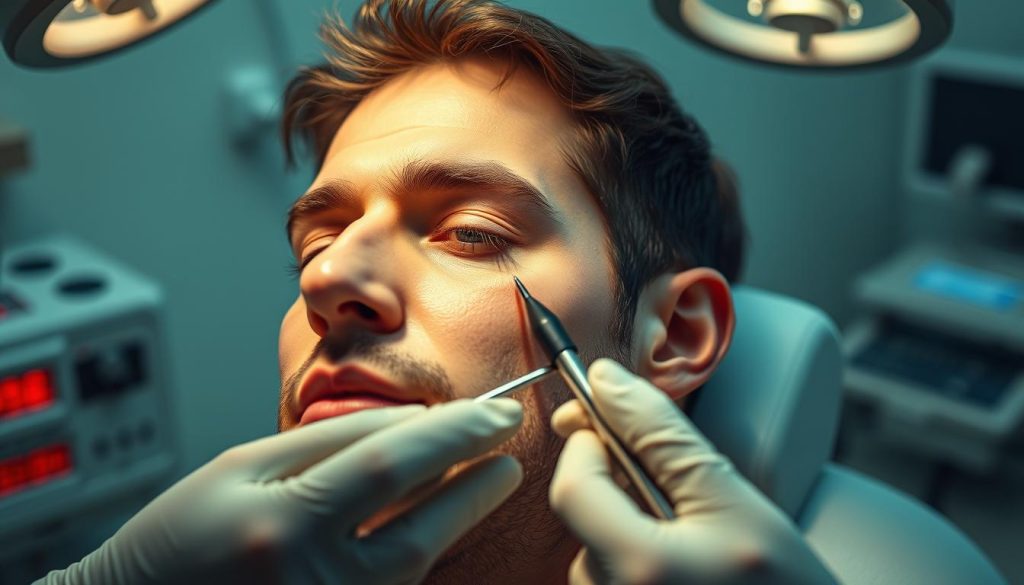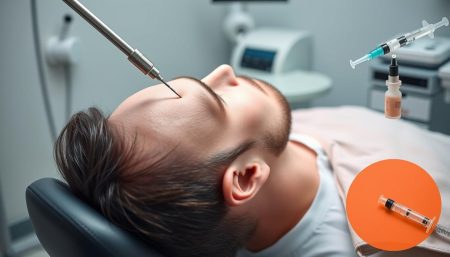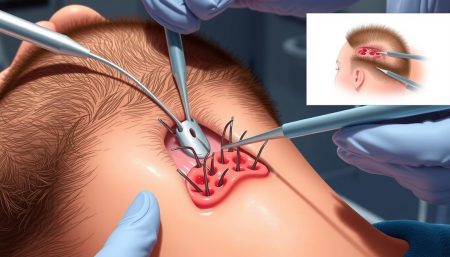Facial hair transplants are a lasting fix for men with patchy or sparse beards and moustaches. This new method of facial hair restoration is becoming more popular. It helps men look better and feel more confident.
More men are choosing this procedure because it gives natural-looking results. It moves hair follicles from one area to another. This way, men can get the full, thick beard they’ve always dreamed of.
This article will explore facial hair transplants in detail. We’ll look at the science, different techniques, and what to expect. We’ll cover everything from your first consultation to caring for your new hair long-term.
Understanding Facial Hair Transplantation: A Modern Solution
Facial hair transplantation has changed the game in hair care. It offers a lasting fix for men wanting fuller facial hair. This method uses the latest technology to give natural-looking results. It helps those with thin or uneven facial hair.
The Science Behind Hair Follicle Growth
Hair follicles grow, rest, and shed in cycles. In a facial hair transplant, healthy follicles are moved from donor areas to the face. They start growing again, giving strong facial hair.
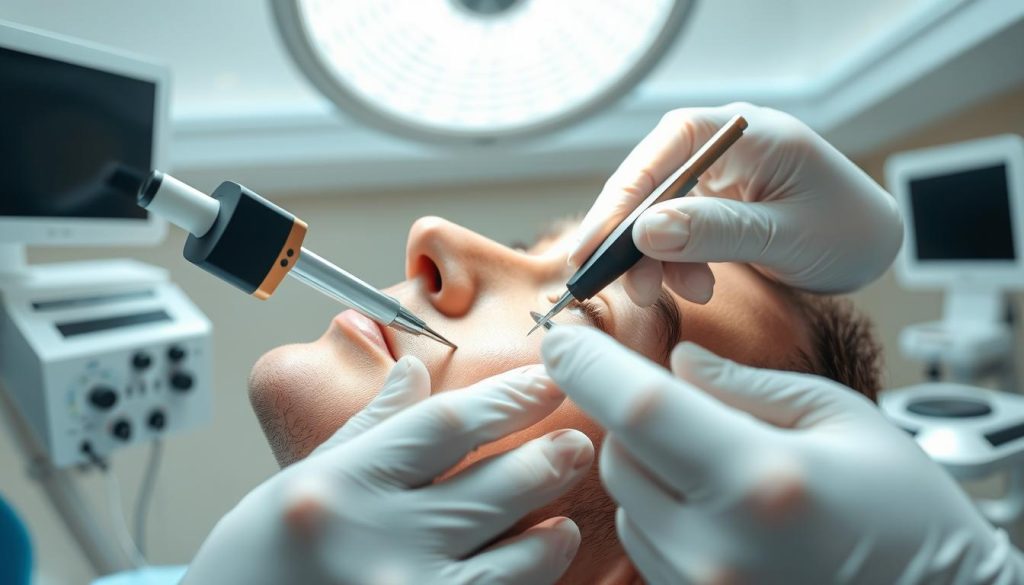
Natural-Looking Results Through Advanced Techniques
Today’s facial hair enhancements use advanced methods for a natural look. Surgeons plan the angle and density of the transplanted hair carefully. This makes the new hair blend seamlessly with the existing.
Evolution of Facial Hair Restoration Methods
Facial hair transplantation has come a long way. Old methods didn’t always look natural, but now they do. New tools and techniques have made transplants more effective and popular for fuller facial hair.
Types of Facial Hair Transplant Procedures
Facial hair transplants offer men a lasting fix for fuller beards and moustaches. These methods have become more popular as they improve. Let’s look at the main types of facial hair transplant procedures today.
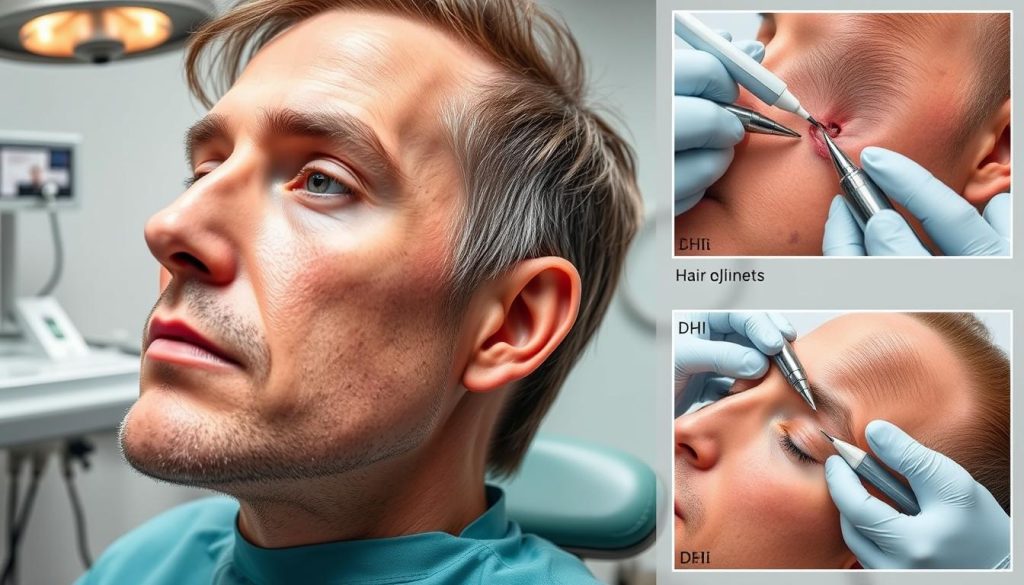
The two main methods are Follicular Unit Extraction (FUE) and Follicular Unit Transplantation (FUT). Each method has its own way of taking and putting hair follicles in place.
| Procedure | Harvesting Method | Scarring | Recovery Time |
|---|---|---|---|
| FUE | Individual follicles extracted | Minimal | 1-2 weeks |
| FUT | Strip of skin removed | Linear scar | 2-3 weeks |
FUE is often chosen for beard restoration because it causes little scarring and heals fast. In this method, single hair follicles are taken from the donor area and put into the beard or moustache.
FUT, by contrast, takes a strip of skin with hair follicles. It can do more grafts at once but leaves a line scar at the donor site.
Both methods can be used for moustache transplantation. The choice depends on the patient’s needs and the surgeon’s advice. The success of these procedures depends on the surgeon’s skill and the quality of the donor hair.
Follicular Unit Extraction (FUE) for Facial Hair
Follicular unit extraction has changed facial hair transplant surgery. It’s a precise and gentle way to improve your beard, moustache, or sideburns.
Step-by-Step FUE Process
The FUE process starts with taking out individual hair follicles from the back of the head. These follicles are then placed in the areas you want to enhance. This careful method gives natural-looking results and little scarring.
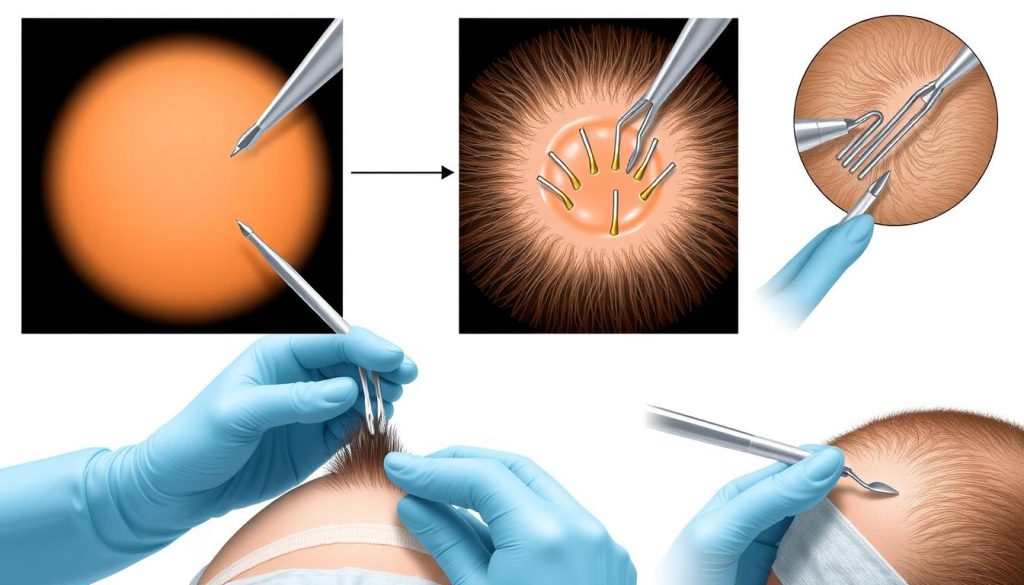
Benefits of FUE Technology
FUE technology has many benefits over old hair transplant methods:
- Minimal scarring
- Quicker recovery time
- Natural-looking results
- Flexibility in hair design
Recovery Timeline After FUE
Recovery from FUE is quick. Most people can go back to work in a few days. The transplanted hair falls out in two weeks, and new growth starts three months later. You’ll see the full results in 12-18 months.
| Time Frame | Recovery Milestone |
|---|---|
| 1-3 days | Initial healing, minor swelling |
| 1-2 weeks | Scabs form and fall off |
| 3-4 months | New hair growth begins |
| 12-18 months | Full results visible |
Follicular Unit Transplantation (FUT) Method
Follicular unit transplantation is a well-known hair transplant surgery. It helps people who want to grow back their facial hair. The method takes a strip of hair-bearing skin from the back of the head.
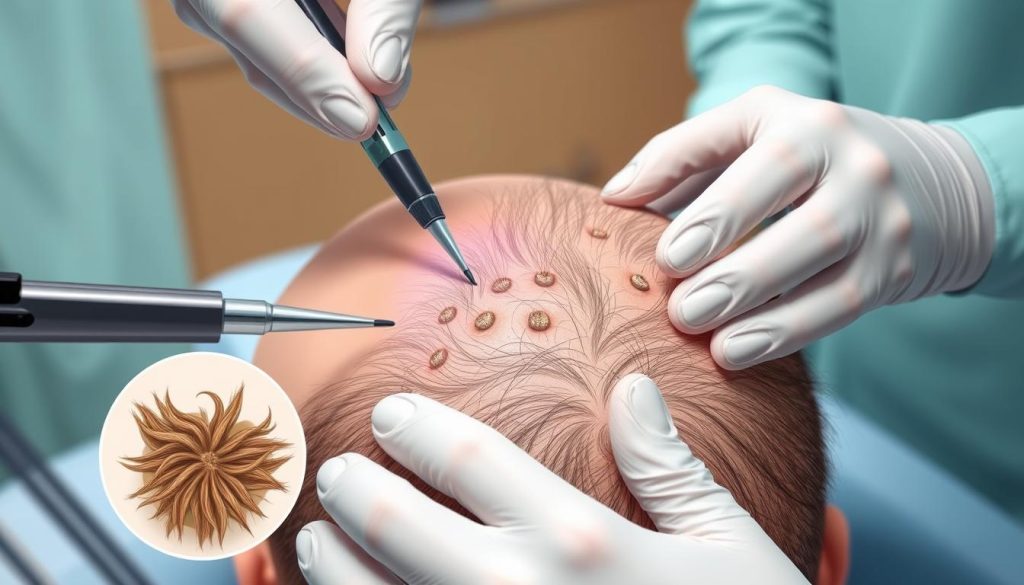
The first step is to remove a thin strip of scalp. Then, under a microscope, the surgeon carefully separates individual follicular units. These units are then moved to the area where you want your beard or moustache to be.
Even though FUT can give great results, it leaves a scar. This scar can be hidden with long hair. But, it might show with very short haircuts.
| Aspect | FUT Method | FUE Method |
|---|---|---|
| Scarring | Linear scar | Multiple small scars |
| Recovery time | 2-3 weeks | 1-2 weeks |
| Suitable for | Larger areas | Smaller areas |
| Cost | Generally lower | Usually higher |
The FUT method is best for bigger areas because it can take more grafts at once. It takes longer to recover than FUE. But, many find the results worth it.
Choosing between FUT and other hair transplant methods depends on several things. These include how much hair you’ve lost, how much hair you have to spare, and what you prefer. Talking to a skilled surgeon can help decide the best way to restore your facial hair.
Ideal Candidates for Beard and Moustache Restoration
Beard restoration and moustache transplantation can change lives. But, not everyone is a good fit. Knowing what’s needed helps manage expectations.
Age and Health Requirements
Men over 25 are usually the best for these transplants. At this age, hair growth patterns are set. Being in good health is also key for success. Conditions like diabetes can impact healing and results.
Hair Donor Site Evaluation
Checking the donor area is essential. The scalp is often the main source for these transplants. The best candidates have:
- Sufficient donor hair density
- Similar hair texture to facial hair
- Good hair follicle health
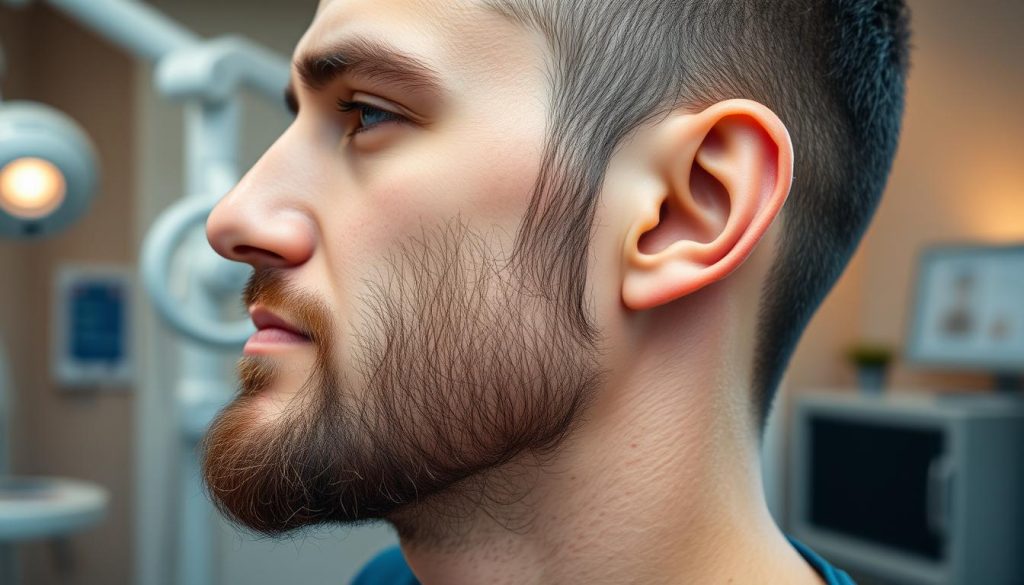
Expectations Management
Setting realistic goals is important for happiness with the results. Candidates should know:
- Natural-looking results take time
- Multiple sessions may be necessary
- Final results can take up to a year
| Factor | Ideal Candidate | Less Suitable Candidate |
|---|---|---|
| Age | 25+ years old | Under 25 years old |
| Health | Excellent overall health | Chronic health issues |
| Donor Hair | Dense, similar to facial hair | Sparse, dissimilar to facial hair |
| Expectations | Realistic, patient | Unrealistic, impatient |
The Consultation Process and Treatment Planning
The journey to a fuller facial hair starts with a detailed consultation. Here, patients look into options for facial hair transplant and restoration. A skilled surgeon will assess your unique features and discuss your desired look.
At the first meeting, you’ll talk about your medical history and lifestyle. The surgeon will look at your facial structure, hair patterns, and where hair can be taken from. This detailed check helps create a treatment plan just for you.
It’s important to talk openly about what you want and any worries you have. Your surgeon will explain the different ways to restore facial hair. They will help you pick the best method for you.
“A successful facial hair transplant starts with a detailed consultation and tailored treatment plan,” says Dr Emily Thompson, a renowned hair restoration specialist.
By the end of the consultation, you’ll get a treatment plan. This plan will tell you how many grafts you’ll need, the technique used, and when you can expect the procedure and recovery.
| Consultation Step | Purpose |
|---|---|
| Medical History Review | Assess eligibility and possible risks |
| Physical Examination | Check hair quality and donor site |
| Treatment Discussion | Explain options and set realistic expectations |
| Customised Plan Creation | Develop a tailored approach for the best results |
Remember, a well-planned facial hair transplant can greatly improve your look and confidence. Take your time to find a qualified surgeon who knows your goals and can help you through this change.
Cost Considerations and Investment Analysis
Understanding the financial side of facial hair enhancement is key for those thinking about hair transplant surgery. The cost can vary a lot, depending on several things.
Price Factors and Variables
The size of the transplant, the technique used, and the surgeon’s skill all affect the price. Getting a full beard done costs more than a moustache or goatee. FUE methods are pricier than FUT because they use new tech and leave less scarring.
| Procedure Type | Average Cost Range (USD) |
|---|---|
| Full Beard Transplant | 4,000 – 15,000 |
| Moustache Transplant | 3,000 – 7,000 |
| Goatee Transplant | 5,000 – 10,000 |
Insurance Coverage Options
Most insurance plans don’t cover facial hair transplants because they’re seen as cosmetic. But, it’s worth checking with your provider. Sometimes, there might be exceptions for reconstructive needs after accidents or burns.
Financing Solutions Available
Many clinics have financing options to help make hair transplant surgery more affordable. You might find instalment plans, medical credit cards, or personal loans. It’s important to look at the terms and interest rates before choosing a financing option for your facial hair enhancement.
Even though the upfront cost might seem high, many find the long-term benefits of facial hair transplants worth it. They boost confidence and help achieve the look you want.
Recovery and Post-Procedure Care Guidelines
Proper care is key after a facial hair transplant. The recovery has several stages. Each stage needs special attention for the best results.
In the first 24 hours, rest and avoid touching the treated areas. Swelling and mild discomfort are normal. They can be managed with the right medication. Sleeping with your head up can also help reduce swelling.
In the first week, clean the donor and recipient sites gently. Follow your surgeon’s instructions closely. This helps prevent infection and promotes healing. It’s normal for some transplanted hairs to fall out as part of their growth cycle.
After two weeks, you can start with light activities. But, avoid hard exercise and direct sun for at least a month. The transplanted hair follicles are delicate and need time to settle.
| Recovery Stage | Duration | Key Care Points |
|---|---|---|
| Immediate Post-Op | 1-3 days | Rest, elevate head, take prescribed medications |
| Early Recovery | 1-2 weeks | Gentle cleaning, avoid touching grafts |
| Mid Recovery | 2-4 weeks | Resume light activities, protect from sun |
| Late Recovery | 1-3 months | Gradual return to normal routines |
Full recovery and visible results take several months. Keep regular appointments with your surgeon. This helps monitor progress and address any concerns during your facial hair transplant journey.
Potential Risks and Complications
Facial hair restoration and hair transplant surgery are popular for improving looks. But, they also have risks and side effects. It’s important to know these before starting treatment.
Common Side Effects
After a facial hair transplant, you might see swelling, redness, and numbness. These usually go away in a few days to weeks. You might also see small scabs around the new follicles. This is part of healing.
Long-term Considerations
Facial hair restoration can look great, but there are long-term things to think about. You might see uneven growth or not be happy with the results. In rare cases, some hairs might not grow right, making your facial hair look patchy or uneven.
Prevention Strategies
To lower risks from hair transplant surgery, try these:
- Choose a qualified and experienced surgeon specialising in facial hair restoration
- Follow pre-operative instructions carefully
- Adhere to post-procedure care guidelines meticulously
- Attend all follow-up appointments to monitor progress and address any concerns
| Risk | Prevalence | Prevention |
|---|---|---|
| Infection | Rare | Proper hygiene, antibiotic use |
| Scarring | Low | Skilled surgeon, proper aftercare |
| Uneven growth | Moderate | Realistic expectations, follow-up treatments |
Knowing these risks and taking steps to prevent them can help. This way, you can make better choices for your facial hair restoration. It can also help you get the results you want.
Expected Results and Timeline
Starting your facial hair journey needs patience and clear expectations. Beard restoration takes time, growing over months.
At first, the transplanted hair might fall out in the first few weeks. This is normal and shouldn’t worry you. It’s just part of hair growth.
By the three-month mark, new hair starts to grow. You’ll see small, fine hairs from the transplanted follicles. These will get thicker and darker as time goes on.
| Timeline | Expected Progress |
|---|---|
| 1-2 weeks | Initial healing, possible shedding |
| 3-4 months | First signs of new growth |
| 6-8 months | Noticeable improvement in density |
| 12-18 months | Full results visible |
By six months, you’ll see big changes in your facial hair. The hairs will keep getting thicker and stronger.
By 12 to 18 months, your beard will look full and ready to style. You can groom it as you like.
“The journey to a fuller beard is a marathon, not a sprint. Patience is key to achieving the best possible results.”
Keep in mind, results can differ. This depends on genetics, health, and following care instructions.
Maintaining Your Transplanted Facial Hair
After a facial hair transplant, keeping it in top shape is key. A good care plan helps your new hair stay healthy and look great.
Daily Care Routine
Start with gentle cleaning. Use a mild, sulphate-free shampoo for your beard or moustache every other day. Gently pat dry with a soft towel and avoid rubbing hard. Use a light, non-greasy moisturiser to keep the skin moist.
Products and Tools Recommended
For the best facial hair care, choose the right products:
- Beard oil to nourish hair and skin
- Beard balm for styling and conditioning
- Wide-toothed comb for detangling
- Soft bristle brush for grooming
Long-term Maintenance Tips
For lasting results from your facial hair transplant:
- Trim regularly to maintain desired shape
- Protect facial hair from sun damage with SPF products
- Eat a balanced diet rich in biotin and protein
- Stay hydrated to promote healthy hair growth
- Avoid harsh chemicals and heat styling tools
By sticking to these tips, your facial hair transplant will keep looking great for years.
Alternative Solutions to Facial Hair Transplant
There are many ways to restore facial hair without surgery. These options are great for those who can’t have transplants or prefer gentler methods.
Minoxidil is a topical solution that helps hair grow. It’s available over the counter and can help with facial hair. Hormone therapy, given by doctors, can also help, mainly for men with low testosterone.
Microneedling uses tiny needles to boost hair growth. It’s often used with topical treatments for better results.
Microblading is a semi-permanent fix for a fuller beard or moustache. It’s a tattoo-like method. Temporary hair fibres give a quick solution for sparse hair.
| Method | Duration | Cost | Effectiveness |
|---|---|---|---|
| Minoxidil | Ongoing | Low | Moderate |
| Hormone Therapy | Long-term | High | Variable |
| Microneedling | Periodic | Medium | Moderate |
| Microblading | 1-3 years | High | Immediate |
| Hair Fibres | Daily | Low | Temporary |
These alternatives offer different ways to enhance facial hair. But, they’re not as permanent as transplants. Think about the cost, time, and what you want before choosing a method.
Choosing a Qualified Surgeon and Clinic
Finding the right surgeon for your facial hair transplant is key. Look for board-certified experts with lots of experience in hair transplant surgery. Make sure they have the right skills for facial hair procedures.
Choose a clinic with modern facilities for your transplant. Look at before-and-after photos of past patients. These can show you what the surgeon can do for you.
Reading patient reviews can help you understand the clinic’s quality. Look for feedback on everything from the first meeting to aftercare. It’s smart to meet with several surgeons to see who fits your needs best.
Success in hair transplant surgery comes from the surgeon’s skill and the clinic’s care. Take your time to choose wisely. Make sure you’re happy and confident with your decision for this big change.
FAQ
Q: What is a facial hair transplant?
A: A facial hair transplant moves hair follicles from the scalp to the face. It’s done to grow more facial hair. This can help with beard growth, moustache, or to fill in sparse areas.
Q: How long does a facial hair transplant procedure take?
A: The time needed for a facial hair transplant varies. It can take 3 to 8 hours. FUE methods usually take longer than FUT.
Q: Is facial hair transplantation permanent?
A: Yes, it’s a permanent fix. The transplanted hair follicles resist hair loss hormones. But, hair density may decrease with age.
Q: How long does it take to see results after a facial hair transplant?
A: Results start to show in a few months. But, it takes 9 to 12 months for full results. The hair sheds first, then grows back in 3 to 4 months.
Q: Are there any risks or side effects associated with facial hair transplants?
A: There are risks, like swelling and numbness. Serious issues like infection or scarring are rare. Choosing a skilled surgeon lowers these risks.
Q: Can I shave after a facial hair transplant?
A: Avoid shaving for two weeks after the transplant. This lets the follicles heal. After, use an electric razor to avoid irritating the new hair.
Q: How much does a facial hair transplant cost?
A: Costs vary based on the transplant’s size, technique, and surgeon’s experience. In the UK, it’s £3,000 to £7,000 or more. Insurance usually doesn’t cover it.
Q: Are there any alternatives to facial hair transplants?
A: Yes, there are other ways to enhance facial hair. Options include minoxidil, hormone therapy, and microneedling. But, they might not last as long as a transplant.
Q: Can facial hair transplants be performed on eyebrows?
A: Yes, eyebrow transplants are available. They help with thin or missing eyebrows. This is due to over-plucking, scarring, or genetics.
Q: How do I choose a qualified surgeon for my facial hair transplant?
A: Choose a board-certified surgeon with facial hair experience. Check their credentials and before-and-after photos. Read testimonials and compare surgeons to find the right one.












